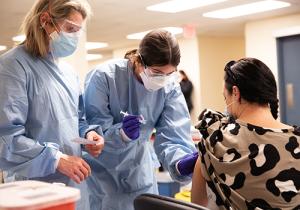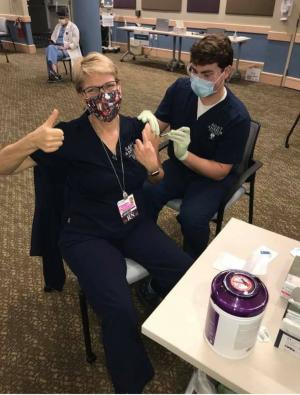The ongoing global health pandemic has transformed virtually every aspect of “normal life.” Saint Anselm College nursing students are living these changes first-hand in their classes and clinical placements. Professors have altered lectures, classwork, simulations, and clinical experiences to educate the future nurses about this pivotal time for the profession.
Such changes range from accounting for additional time to practice donning PPE to discussing the psychological implications of isolation. All the while, the program continues to focus on teaching students to provide holistic, individualized care for each patient.
The pandemic has also impacted logistics and student placement in the community. As part of the curriculum, students are placed in clinical rotations to gain real-world experience through their courses. Although some regular community learning sites are no longer accepting student nurses to minimize exposure to the virus, new opportunities have arisen.

In addition to or instead of their usual sites, this year’s Community Health Nursing students were placed at local vaccination and testing facilities, such as Catholic Medical Center, Elliot Hospital, and the Nashua Department of Health. Each student participated in a Point of Distribution (POD) site, either vaccinating or testing the population for COVID-19. Many of the vaccination clinical experiences the students participated in were dedicated to populations that have health care inequities – the impoverished, minority, and elderly. The clinical experiences brought the vaccines to those members of society who would not have had the opportunity to be vaccinated otherwise.
“Being a part of the solution, even though a small role, will be something us student nurses will be able to hold onto for the rest of our lives,” said Benjamin Norris ’22 about his time distributing vaccines.
According to Professor Pamela Preston, there was no hesitancy among nursing students to embrace the change and help out with vaccinations and testing; they jumped at the opportunity. Some students even came back to assist with vaccinations during their winter break.
“[Students are] very enthusiastic about helping out in this once-in-a-lifetime pandemic opportunity,” remarked Preston.
Meanwhile, this semester’s Critical Care Nursing students are caring for COVID or suspected COVID patients in intensive care units (ICU) during their hospital clinical experiences.
While this experience has come with its own set of challenges, students are able to engage with the intense nursing interventions involved with caring for a patient on a ventilator managing multiple intravenous infusions and maintaining strict COVID precautions.
“It is a whole new world wearing an N95 mask the entire day you are at clinical,” said Critical Care Nursing Professor Carrie MacLeod.
Nonetheless, students are eager to get out and help. “The work that the healthcare community has put in to save and help the ones affected by COVID is something I am proud to be a part of,” said Jessica Gendreau ’22.
In the classroom, professors have incorporated conversations around COVID to provide real-life examples of course concepts. For instance, Professor Caryn Sheehan’s Pathopharmacology course includes information about the FDA’s process for fast-tracking approval of COVID medications and vaccines
Similarly, Professors Carrie MacLeod and Destiny Brady added content focused on the multi-system impact of COVID in lectures about caring for a critically ill patient. For the first time this spring, a virtual family communication component was added to simulation labs. Students can practice interacting with a patient's family member on Zoom or Facetime. These real-time experiences helped the students recognize the impact of COVID on nurse-patient-family communication.
“Almost every class has included COVID-19 concepts into what we are learning,” said Norris. “Especially with Community Health Nursing, it was something that had to be included within our curriculum.”
The pandemic has also adjusted the nursing program’s overall structure for this year. For instance, due to the high risk of exposing vulnerable long-term care residents to the virus, sophomore nursing students in their Care of the Elderly and Chronically Ill nursing course now start their first clinical placement in a hospital setting, rather than a long-term care facility.
In the past, the first clinical rotation for sophomore students took place in nursing homes whereas now, students embark on their clinical journey in a fast-paced hospital setting with complex patients.

“So far, clinical faculty and nursing students have adapted well,” said Sheehan, despite the new alterations.
“For everyone at Saint Anselm, this has been a difficult time,” said Preston. “But the nursing students in particular have been so dedicated to this cause.”
On top of their coursework and clinical experiences, nursing students are, after all, college students. When their shifts end, and they are done vaccinating or caring for those on ventilators, they rejoin their classmates on the Hilltop.
“My friends and I still find ways to hang out on campus, whether it is attending CABingo, eating at the C-shop, or taking walks on the trails on a nice day of course,” said Gina Gagliardi ’22.
The pandemic has created a new sense of appreciation for healthcare workers, particularly nurses. The Saint Anselm community, however, has held a heightened respect for nurses long before COVID began.
“To me, nurses have always been heroes,” concluded Gagliardi.
On the Hilltop, that reputation is expected to remain.
